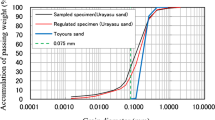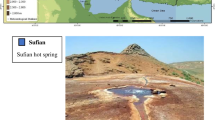Abstract
In the present study, by simulating an experimental model of a coastal dike (8 m long, 1 m deep and 1 m wide) by FLAC-2D software based on finite difference method, the soil failure mechanism caused by seepage force has been performed. To solve this problem in order to study the boiling, the soil foundation should be analyzed at the most critical condition. The numerical model presented in FLAC-2D is properly able to simulate the flow properties (flow velocity, hydraulic conductivity and seepage discharge). Comparing the results from the numerical model with experimental data shows that the numerical model well predict soil behavior including boiling and soil displacements based on stress–strain analysis. The simulation indicated that dilation and internal friction angles also influenced the stability coefficient.



















Similar content being viewed by others
References
Barchard J (2002) Centrifuge modeling of piled embankments on soft soil. M.Sc Thesis, Graduate Academic Unit of Civil Engineering, University of Brunswick, USA, pp 1396–1400
Bear J (1972) Dynamics of fluids in porous media. American Elsevier Publishing Company, New York, pp 184–194
Benmebarek N, Benmebarek S, Kastner R (2005) Numerical studies of seepage failure of sand within a cofferdam. Comput Geotech 32:264–273
Das B (1941) Principles of geotechnical engineering. University of Texas at El Paso, El Paso, pp 160–195
FLAC-2D (2000) Fast Lagrangian analysis of continua. ITASCA Consulting Group, Minneapolis, pp 835–1150
Javan M, Farjood M.R (1993) Evaluation of foundation seepage at Doroodzan Earth Dam. In: Proceedings of the international conference on environmental management, geo-water and engineering aspects, Feb. Wollongong, A.A Balkema, pp 8–11
Kuriqi A, Ardiclioglu M (2005) Investigation of hydraulic hegime at middle part of the Loire River in context of floods and low flow events. Pollack Period 13(1):145–156
Kuriqi A, Ardiclioglu M, Muceku Y (2016) Investigation of seepage effect on river dike’s stability under steady state and transient conditions. Pollack Period 11(2):87–104
Lane EW (1935) Security from under seepage masonry dams on earth foundations. Proc Am Soc Civil Eng 60:929–966
McNamee J (1949) Seepage into a sheeted excavation. Geotechnique 4(1):229–234
Neuman SP, Witherspoon PA (1970) Finite element method for analyzing steady seepage with a free surface. Water Resour Res 6:889–897
Rahimi H (2003) Embankment dams. University of Tehran Press, Tehran (in Farsi)
Sedghi-Asl M, Rahimi H, Khaleghi H (2005) Optimal positioning of vertical sheet pile to reduce seepage and flow under hydraulic structures using numerical model. In: 5th Iranian Hydraulic Conference. Kerman University, Kerman, Iran, pp 305–310 (in Farsi)
Sedghi-Asl M, Rahimi H, Khaleghi H (2010) Experimental analysis of seepage flow under coastal dikes. Exp Tech 34(4):49–54
Sedghi-Asl M, Rahimi H, Khaleghi H (2012) Laboratory investigation of the seepage control measures under coastal dikes. Exp Tech 36(1):61–71
Sedghi-Asl M, Parvizi M, Armin M, Flores-Berrones R (2015) Internal Erosion under a spillway rested on an embankment dam. Int J Min Geo-Eng 49(2):269–279
Subramanian N (2008) Design of steel structures. Oxford University Press, Oxford
Tanaka T, Verruijt A (1999) Seepage failure of sand behind sheet piles. The mechanism and practical approach to analyze. Soils Found 39(3):27–35
Tanaka T, Yokoyama T (2006) Effects of jet grouting under sheet piles on seepage failure stability of soil. In: Geotechnical aspects of underground construction in soft ground. London, pp 923–926
Tanaka T, Takashima W, Pham TTH, Utra K, Uemura N (2012) A case study on seepage failure of bottom soil within a doublesheet-pile-wall-type ditch. In: ICSE6, Paris. pp 27–31
Teng W, Chen C (2013) Enhanced effects of flood disasters due to hillside development in urban areas. Water 5(1):224–238
Terzaghi K (1943) Theoretical soil mechanics. Wiley, New York
Wilkins ML (1964) Fundamental methods in hydrodynamics. In: Methods in computational physics. Academic Press, New York, pp 211–263
Acknowledgements
Funding was provided by Yasuj University of Civil Engineering.
Author information
Authors and Affiliations
Corresponding author
Additional information
Publisher's Note
Springer Nature remains neutral with regard to jurisdictional claims in published maps and institutional affiliations.
Rights and permissions
About this article
Cite this article
Azar, E., Parvizi, M. & Rahimi, H. Numerical Modeling of Fluid Sand Boiling from Coastal Dike Foundations. Geotech Geol Eng 38, 1619–1629 (2020). https://doi.org/10.1007/s10706-019-01116-4
Received:
Accepted:
Published:
Issue Date:
DOI: https://doi.org/10.1007/s10706-019-01116-4




